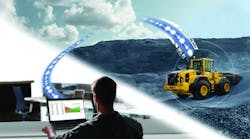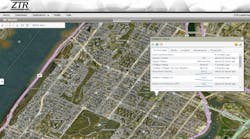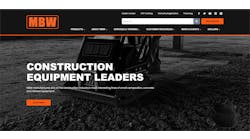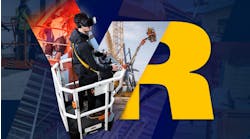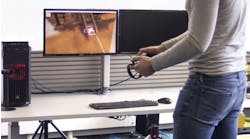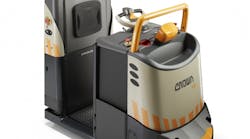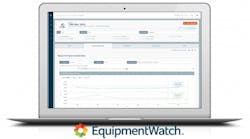Successful fleet management — in any industry — requires meticulous attention to detail and a near-clairvoyant ability to predict and prevent machine problems. But rental fleet managers, in particular, face some uniquely challenging issues. A rental business doesn’t always have the luxury of visibility into the daily use of each machine in their fleet, and operators don’t necessarily feel the same level of responsibility for care of a rental machine as they would a machine owned by their boss. That is, unless the rental business uses an adequately monitored and managed telematics system, in which case they have complete visibility.
Telematics is much more than it used to be. What once was a way of simply providing the fleet manager GPS location information, telematics can now be used to monitor machine usage, oversee operator behavior, provide remote diagnostics and enable anti-theft measures — all of which provide significant opportunity for rental businesses to improve the way they manage their fleet and their bottom line.
Most recent telematics technologies don’t necessarily require constant monitoring for the fleet manager to reap the benefits. How? Real-time service alerts. These helpful messages can be sent via text message or email to inform the fleet manager of issues at hand, such as out-of-whack coolant levels, oil levels or error codes that need attention.
Should a fleet manager be willing to dive deeper, machine-specific utilization data can help predict the life span of wear parts, thus avoiding downtime and maintaining the proper stock of parts for planned maintenance. For instance, excavator-specific data can show a record of which attachments are being used and for how long. Additionally, utilization data for wheel loaders and articulated haulers such as idle times, number of starts and stops, average speeds and engine revving can all point to a potential need for better training of the operators in order to reduce unnecessary wear on the machine.
Skip trips
Maximizing uptime is every fleet manager’s goal — rental or otherwise. When a machine is down, it’s not generating revenue, and that’s unacceptable. But for the rental fleet manager especially, machine downtime can pose logistical challenges that eat up time and resources.
Without telematics, a rental fleet manager might get an unexpected call from the renter when a machine’s down. The rental fleet manager must make a site visit to diagnose the issue. Not knowing what to expect, he might not know who to bring, what tools or parts will be required, and whether or not a loaner machine will be necessary. After making the trip and diagnosing the issue, a second or even third site visit may be necessary in order to carry out the service and/or machine swap(s). This equates to increased labor and fuel costs, but also lost revenue for the associated customer downtime.
With telematics, the fleet manager can run remote diagnostics from the comfort of the shop to determine the problem and ensure the proper resources are brought to the site in one trip — or perhaps determine a site trip isn’t necessary at all. Better yet, the fleet manager is able to use telematics to catch the problem before it arises.
Sync service schedules
Managing scheduled service for a large rental fleet can be a logistical nightmare. In an ideal world, service intervals would align with periods when the machine is between renters. However, that’s not always feasible. Renters often extend contracts beyond the original length of the agreement, or can put more hours on a machine over a shorter period of time than originally expected. Both scenarios can lead to missed or late service intervals — and ultimately, more wear on the machine.
With telematics, the rental fleet manager will not only be notified of service alerts and error codes on the machine, but will have real-time access to machine hours and usage. On a long-term rental, this makes service intervals much more predictable. And predictability is the key to ensuring a comparable machine is available for the renter if a service interval is required in the midst of a renter’s contract.
Thwart thieves
Heavy equipment thefts are out there, and their activity is reportedly on the rise, according to the National Insurance Crime Bureau, whose 2013 report showed a total of 11,486 heavy equipment thefts — a 5 percent spike from 2012. The same report details that only 21 percent of the equipment reported stolen was recovered. The number of recovered machines would be significantly higher had more machines been outfitted with telematics.
Using telematics, the fleet manager can set parameters for where and when the machine is being used. If the machine starts up outside of the predetermined time parameters or travels outside the geo-fenced area, the fleet manager will be alerted and can remotely track the location of the machine. Additionally, some equipment can be outfitted with anti-theft features that work in concert with telematics, which can disable the engine until such time that the fleet manager is able to enter a code on the keypad.
Reform reimbursement
All work is not created equal. A renter using an excavator for two hours of light dirt trenching per day puts much less stress on the machine than a renter who is stripping rock on an aggregate site 12 hours per day. A rental business should have a good sense of the intended use of the machine when developing a rental contract and the associated pricing. Without telematics, however, once the machine leaves the lot, the business doesn’t necessarily have visibility to how the machine is used.
Using telematics, the rental fleet manager can use location tracking to determine if the machine is working in an area that would indicate a different use than expected — such as an area known for surface mining or aggregates. Additionally, machine hours and utilization reporting can show exactly how the machine is being used, which hydraulic functions are being engaged and for how long. If the data suggests use outside the agreed-upon terms, the rental business has potential justification to revise use to those terms.
Facilitate follow-through
While telematics is a very valuable tool, not all rental business owners or fleet managers have adequate time to take full advantage of the data gathered from the systems. That’s why some manufacturers offer dealer-managed maintenance programs that can be customized to include telematics monitoring services.
Rental business owners can benefit from manufacturer programs such as Volvo SmartCare that entail customizable service agreements with their dealer to include everything from a range of warranty options; fuel efficiency and uptime guarantees; dealer-provided telematics monitoring services; and on-site trainings, service and inspections. Programs like these can reduce downtime, cut down on administrative and labor costs, and ensure any maintenance is predictable and planned.
Kent Somerville is director, national rental accounts at Volvo Construction Equipment
